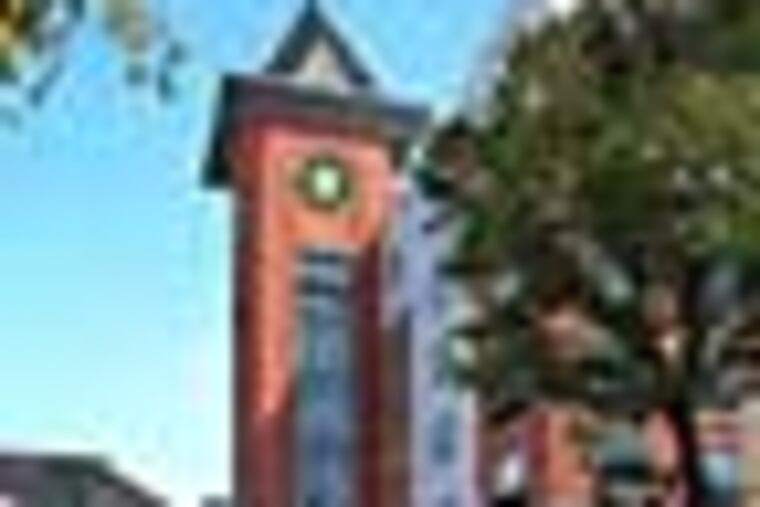Planned Ardmore parking garage drives debate
If all goes as planned, a parking garage will rise late next year behind Scott Mahan's store in Ardmore. For some merchants, the eight-level, $17.6 million structure is a welcome panacea to Ardmore's economic woes.

If all goes as planned, a parking garage will rise late next year behind Scott Mahan's store in Ardmore.
For some merchants, the eight-level, $17.6 million structure is a welcome panacea to Ardmore's economic woes.
For others, such as Mahan, there is a reluctant acceptance of the structure, between Lancaster Avenue and the SEPTA tracks.
"I don't think an eight-story parking garage is the answer, but it's exciting to see something happen," Mahan said.
Lower Merion Township commissioners voted, 9-3, on July 1 to build the garage, the first phase of the $150 million Ardmore Transit Center. The project aims to jump-start the town, whose star has dimmed since the 1960s, when patrons began to spurn it for malls.
Included are a "mini-Main Street" between Lancaster Avenue and the R5 rail line with stores, a five-story apartment building, a new train station with an extended platform, and a walkway to Suburban Square.
"We have a project that, when we're finished, it will bring in new residents, new SEPTA riders, and new customers for neighborhood shops that are really hurting," developer Carl E. Dranoff said.
The Ardmore Initiative, a business-booster group, endorsed the plan, which it sees as the catalyst for a reversal.
"The business community is, like, 'Bring it on,'" executive director Christine Vilardo said. "Let's get started."
The township passed an ordinance allowing for such high-density development.
But some civic leaders say they think the project is so big that it will loom over downtown like Gulliver over Lilliput.
"The scale is quite out of place with everything around it," said Sharon B. Eckstein, president of the Save Ardmore Coalition, a civic group that has not taken a stand on the garage. "Residents do not support this kind of scale."
Matthew Koenig, a principal in JKR Partners and a project architect, said that there are other high-rises in Ardmore, such as the Times Building in Suburban Square, and that the garage would be hidden by existing stores.
"While it is a tall building and does have a certain mass, this is the right location," Koenig said. "It's not a major skyscraper, by any means."
Eckstein wondered whether the transit center would mesh with later plans for Ardmore.
"Where does it fit, and what's the plan?" she said. "Are we going to be reacting to plans for development or can we shape the vision for Ardmore?"
Some merchants insist the key is more short-term parking, but Dranoff said the key is to draw people downtown.
"We want Ardmore to be a destination, not somewhere to go when you can't get a parking spot in Suburban Square," he said.
Dranoff's vision includes living units with retail and parking on Cricket Avenue; an amphitheater or parking on Schauffele Plaza; and retail, residential, and parking on the Ardmore West strip mall.
The transit center replaces a 1950s train station, with a complex based on "transit-oriented development." The term refers to a mix of public and private buildings that encourages people to walk and take the train.
But there's a catch: For officials to use $10 million from SEPTA, the garage must be built for easy commuter access to the Ardmore train station - not on another lot, a half-block to the east, that some favor.
To fit the garage behind Mahan's office-supply store, a $1 million addition to the Police Administration Building built in 2003 would be razed.
The addition contains holding cells for prisoners and evidence lockers. Both would be moved during construction and rebuilt later as part of the garage.
The state pledged $6 million for the garage; $5.8 million is coming from the Federal Transit Administration; $250,000 will come from Montgomery County.
Commissioner V. Scott Zelov has said money to rebuild the addition would not require any new outlay. Taxpayers are still paying off a bond underwriting the addition, Township Manager Douglas S. Cleland said.
Eckstein called razing the addition "wasteful."
"What message do you send to your children? We just built this new building, but we're knocking it down because we don't think much about the [planning] process?" she said.
Koenig said a building is created with "the highest and best use at the moment." But that can change in five years. "You reevaluate it," he said.
The garage would contain 501 parking places - 300 for commuters, leaving 201 spots for shoppers, township employees, and business owners.
Harry Althouse, owner of Harry Treasures & Collectibles, 22 E. Lancaster Ave., worried that competing parkers would leave too few spots for shoppers. Dranoff said the space would be ample.
"It's the best thing that's viable at this time," Althouse said of the garage, "even if it's not really the best thing."